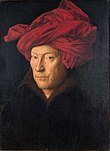Saint Barbara (van Eyck)

Saint Barbara is a 1437 brush stroke drawing on chalk ground laid on an oak panel, signed and dated 1437 by the Netherlandish artist Jan van Eyck. Some areas and passages are more detailed than others, and it has long been debated if the panel was left as van Eyck intended or if it is an unfinished painting. If it was intended as exant, than it would mean it is the earliest surviving drawing of any artist, although not prepared on paper or parchment. Evidence to support this includes that the work was highly regared at the time by Flemish aestheticists as a thing of its-self.[1] In addition the work was widely copied, with many near contemporary lithographs still in good condition.
Saint Barbara was a Christian martyr believed to have lived in the 3rd century, and a popular saint in the late Middle Ages. According to hagiography, her wealthy and pagan father Dioscorus, sought to preserve her from unwelcome suitors by imprisoning her in a tower. Captive Barbara let in a priest who baptised her, an act for which she was hunted and eventually beheaded by her father.[2] She became a popular subject for artists of van Eyck's generation.
Here she is shown seated holding a book and palm leaves in front of a large Gothic cathedral still in the process of being built, with a large number of workmen visible both on the ground carry stone and on various parts of the tower. The work is set against a sweeping and evokative landscape in browns, whites and blues, although it is only sketchily detailed.[3] The elements of the tower are highly described, and contain many complex architectural details. In a number of respects it resembles the Cologne cathedral, which in 1437 was still under construction. van Eyck had earlier depicted the cathedral as well as a view of Cologne in the Adoration of the Lamb panel of the Ghent Altarpiece.[1]
The original marbel frame is painted letters which appear as if chiselled and read IOHES DE EYCK ME FECIT. 1437. As the work is most likely unfinished, the completion referred to in the lettering probably refers to the design of the picture than any completed product finished by workshop members.[4]
Notes
Sources
- Borchert, Till-Holger. Van Eyck. London: Taschen, 2008. ISBN 978-3-822-85687-1
- Borchert, Till-Holger. Van Eyck to Durer: The Influence of Early Netherlandish painting on European Art, 1430-1530. London: Thames & Hudson, 2011. ISBN 978-0-500-23883-7
- Harbison, Craig. Jan van Eyck: the play of realism. London: Reaktion Books, 1997. ISBN 0-948462-79-5

